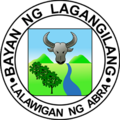Lagangilang | |
|---|---|
| Municipality of Lagangilang | |
 Holy Cross Parish Church of Lagangilang | |
 Map of Abra with Lagangilang highlighted | |
Location within the Philippines | |
| Coordinates: 17°37′N120°44′E / 17.61°N 120.73°E | |
| Country | Philippines |
| Region | Cordillera Administrative Region |
| Province | Abra |
| District | Lone district |
| Barangays | 17 (see Barangays) |
| Government | |
| • Type | Sangguniang Bayan |
| • Mayor | Rovelyn E. Villamor |
| • Vice Mayor | Paul Joseph Q. Abaya |
| • Representative | Menchie B. Bernos |
| • Municipal Council | Members |
| • Electorate | 11,101 voters (2025) |
| Area | |
• Total | 101.44 km2 (39.17 sq mi) |
| Elevation | 111 m (364 ft) |
| Highest elevation | 343 m (1,125 ft) |
| Lowest elevation | 49 m (161 ft) |
| Population (2024 census) [3] | |
• Total | 14,577 |
| • Density | 143.70/km2 (372.18/sq mi) |
| • Households | 3,415 |
| Economy | |
| • Income class | 5th municipal income class |
| • Poverty incidence | 13.82 |
| • Revenue | ₱ 163.4 million (2022) |
| • Assets | ₱ 302.5 million (2022) |
| • Expenditure | ₱ 162.9 million (2022) |
| • Liabilities | ₱ 71.27 million (2022) |
| Service provider | |
| • Electricity | Abra Electric Cooperative (ABRECO) |
| Time zone | UTC+8 (PST) |
| ZIP code | 2802 |
| PSGC | |
| IDD : area code | +63 (0)74 |
| Native languages | Itneg, Ilocano, Filipino |
Lagangilang, officially the Municipality of Lagangilang (Ilocano : Ili ti Lagangilang; Filipino : Bayan ng Lagangilang), is a municipality in the province of Abra, Philippines. According to the 2024 census, it has a population of 14,577 people. [5]



